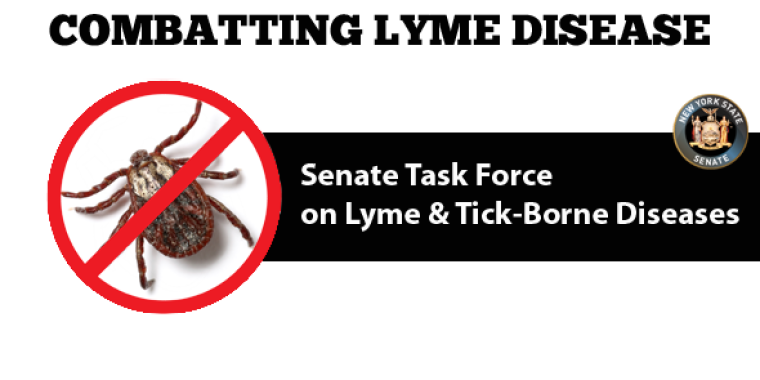
SEN. FARLEY REPORTS SENATE RELEASES TASK FORCE REPORT & RECOMMENDATIONS TO ADDRESS LYME AND TICK-BORNE DISEASES

State Senator Hugh T. Farley (R, C, I – Schenectady) reports the New York State Senate Task Force on Lyme and Tick-Borne Diseases recently released a report and legislation that provides a comprehensive set of recommendations for a state action plan to enhance research, prevention, diagnosis and treatment for harmful tick-borne illnesses. To date in 2014, more than 450 new cases of Lyme disease have been reported in New York alone, and the number is expected to continue rising each year as disease-laden ticks spread to more communities.
The report’s recommendations focus on the need for: additional research and data about past, current and future disease trends; increased public awareness as the reach of the diseases spread to new communities; implementation of preventive measures such as “4 Poster” devices and bait vaccines for animals to reduce the infected tick population; and measures to enhance diagnosis and treatment for those who have the diseases.
Over the past nine months, the Task Force reviewed research, consulted with experts, heard from the public and worked to develop legislation and 19 recommendations to be incorporated into a New York State Action Plan on Lyme and tick-borne diseases. This Action Plan – similar in purpose to one created by the state Department of Health in 2001 to address the West Nile Virus outbreak -- should serve as a comprehensive roadmap for the state to prevent additional illnesses by improving research, education, diagnosis and treatment.
The report recommendations include several important research initiatives aimed at prevention and providing a better understanding of tick-borne diseases, which can be fatal. Additionally, a statewide conference hosted by the Task Force later in the year will be organized to bring together numerous universities and institutes from across the state who are already working on Lyme and tick-borne disease. The conference will focus on building collaboration and data sharing between the research community and the State Health Department and increasing access to federal research grants.
Other recommendations include a public education campaign, opportunities for continuing medical education, and a county learning collaborative. The collaborative is designed to partner counties in the state who have been at the epicenter of this epidemic with counties who are just beginning to experience outbreaks as the diseases move north and west in order to encourage the sharing of best practices.
The full report is available at http://www.nysenate.gov/files/pdfs/2014_LYME_task_force_report_0.pdf
In addition, the Senate is expected to act on a bill (S7854) and recommended by the task force, that codifies existing state health policy by enabling the state’s Office of Professional Medical Conduct (OPMC) to maintain a flexible, case-specific, investigations policy, particularly where new treatments and acceptance by the medical community do not align.
Some individuals infected with Lyme disease may benefit from alternative medical treatment that is not universally accepted by the medical community. Too often, doctors choose not to pursue the alternative treatment – even if they believe it is best for the patient – fearing an investigation or charges by OPMC.
This legislation ensures that determinations of effective and appropriate treatment of Lyme and other illnesses remain in the hands of medical professionals and does not subject practitioners to OPMC identification, investigation or charges based solely on their recommendation or provision of an innovative and effective treatment.
The bill is one of four initiatives that the Senate has implemented or is in the process of implementing during this session to address Lyme and other tick-borne diseases. The others include:
• The Senate will be adopting a resolution calling on the Centers for Disease Control to reevaluate its guidance on Lyme and other tick-borne diseases and for the National Institutes of Health, the Department of Defense, and other federal agencies to provide more funding for these diseases.
• The 2014-15 state budget included $500,000 to support the recommendations being developed by the task force, and $100,000, along with supporting legislation (S2115) and recommended by the task force, for the creation of a 21st Century Work Group for Disease Elimination and Reduction within the Department of Health.
• The Senate will help increase public education through new informational brochures and wallet cards with important information about Lyme or tick-borne disease identification tools and resources.



